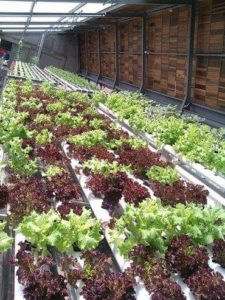Before diving into greenhouse farming, as with any other kind of farming it’s important to weigh the pros and cons in order to be able to develop a successful business plan around the practice, which has been around for centuries and thanks to the ever advancing technology in the agriculture industry is now in the hands of more people. Here’s a list of some of the advantages and disadvantages of greenhouse farming.
The Pros of Greenhouse Farming
1. Increased production
Greenhouse farming is considered an implementation of intensive agriculture and can provide an increase in crop production. This due to the fact that you have more control for creating the optimal climate conditions needed for plant growth and are able to grow more plants per square feet compared to growing crops in an open field.
2. Minimizing production risks
Being in an enclosed space can help prevent crops from suffering damage from climate change related events such as sudden increases or drops in temperature, as well as keeping crops away from birds and other animals.
3. Maximizing profits
Multiple studies have stated that the profits per crop per square feet can be even twice or thrice as big when implementing greenhouse farming as an alternative to open field agriculture and when combining the practice with other strategies such as hydroponics. By utilizing resources in a more efficient manner you’re able to create less waste, which in turn can translate into bigger profits.
4. Increased pests, weeds and disease control
A well designed and optimally built greenhouse can prevent problems such as pests and weeds, as well as provide more control against other diseases. An enclosed space can be restricted to only the necessary personnel, and less people going in and out means a lesser risk of bringing unwanted elements close to the crops.

5. Ability to grow year-round produce, even off-season
A greenhouse is relatively independent to the world outside, which eliminates the limitation of growing crops only on a specific season. Even in the harsh winter or intense summer temperatures high quality crops can be grown, provided you have the necessary means to create the right climate inside the greenhouse.
6. More stability and security
Since you don’t depend on climate conditions, an increase in stability and security, not only for the crops but also for the workers, can be obtained by greenhouse farming.
The Cons of Greenhouse Farming
1. You need a sizeable initial investment
Greenhouse structure and design is relatively expensive, which can be challenging for many farmers. Greenhouse farming is recommended for profitable crops that are easy to commercialize in order to maximize the chances of getting your investment back quickly.
2. Precise greenhouse design
A greenhouse needs to be designed and engineered taking into account very precise details and elements such location, the type of crops that are going to be grown on it, and what kind of technological add-ons are going to be required. If the greenhouse isn’t built properly from the beginning, that could affect the desired results and also mean spending more money down the line.
3. High production costs
Operational costs for greenhouse farming are generally higher than those from open field agriculture. Maintaining adequate conditions for plant growth inside the greenhouse means spending money on electricity and/or gas, just to mention an example.
4. Higher skill level required
Inside the greenhouses your workers are entirely responsible for the plants. Being able to control all the variables of the environment means that any problem that arises is caused by men and should be fixed immediately. This requires prepared and trained professionals that can ensure that the operation can be carried efficiently and safely.
5. Optimal conditions for diseases
Just as the conditions inside a greenhouse will be optimal for crop production, the same can be said for diseases that can affect them. Although it’s true that greenhouse farming can provide better safety measures against such issues, if these aren’t implemented properly there’s still a risk of pests being introduced into the greenhouse and growing faster than usual, which can cause production losses.
6. You need an established market operation
In order to truly take advantage of greenhouse farming it’s imperative that you have your distribution and selling operation already in place. Being able to sell higher quality produce at higher prices is one of the most important advantages of greenhouse farming; such crops have a short life span and need to be commercialized quickly in order to ensure quality. The more time your product spends in storage, the more value it will lose. Having a commercial partner and a robust market will be required and can be a challenge for many.
